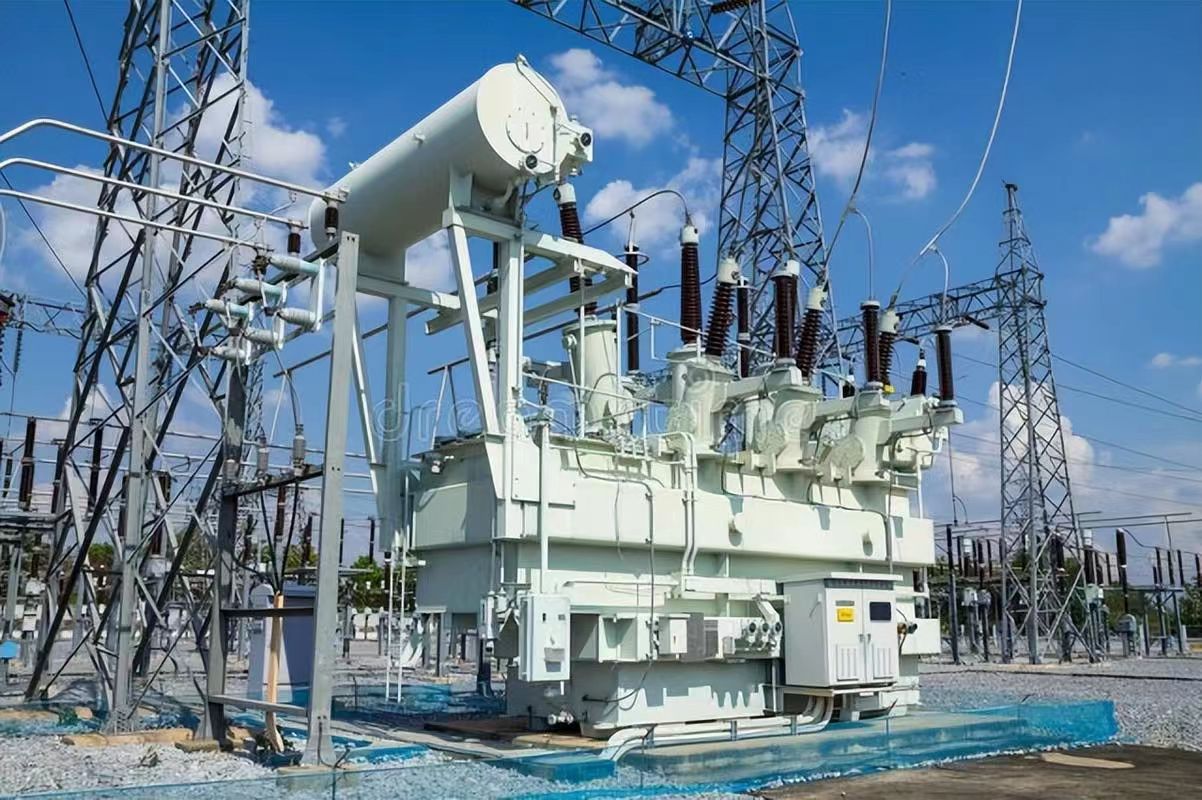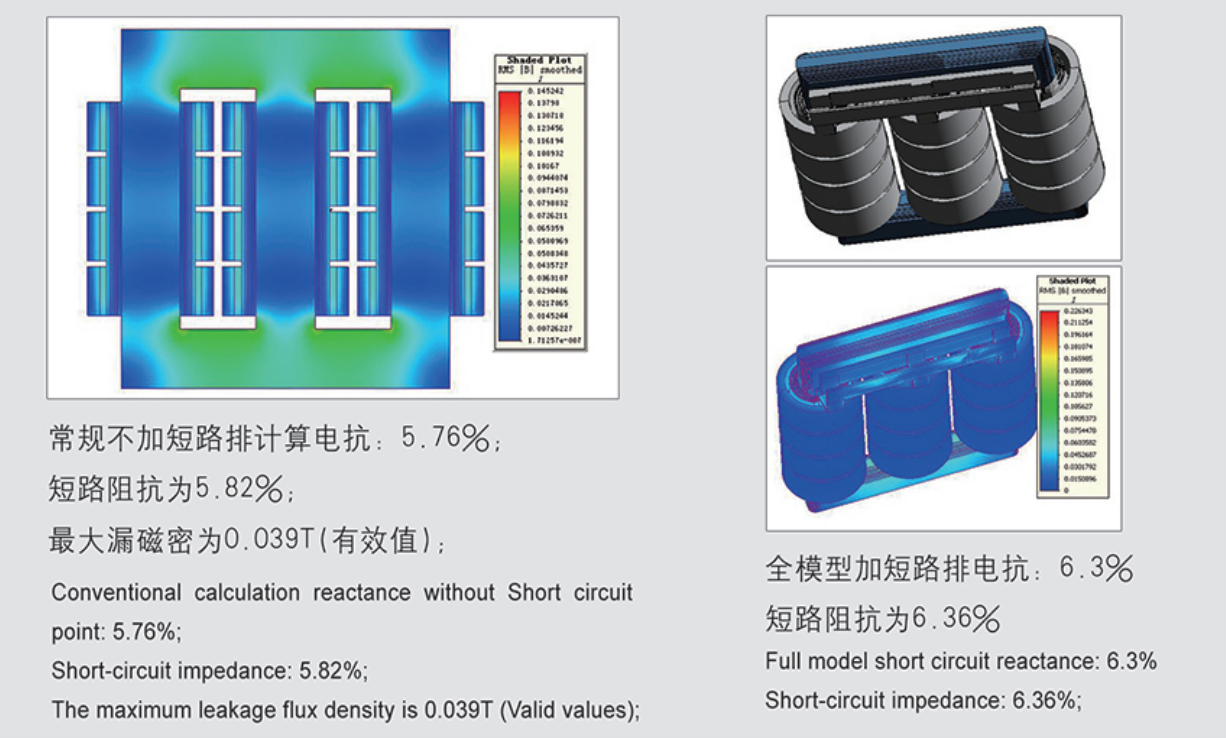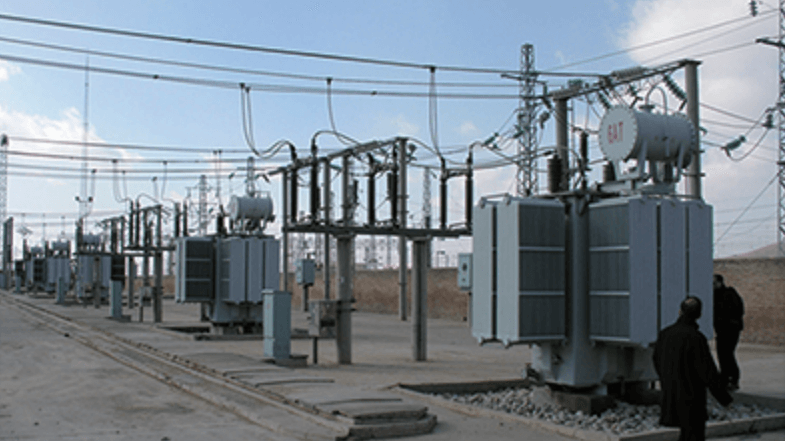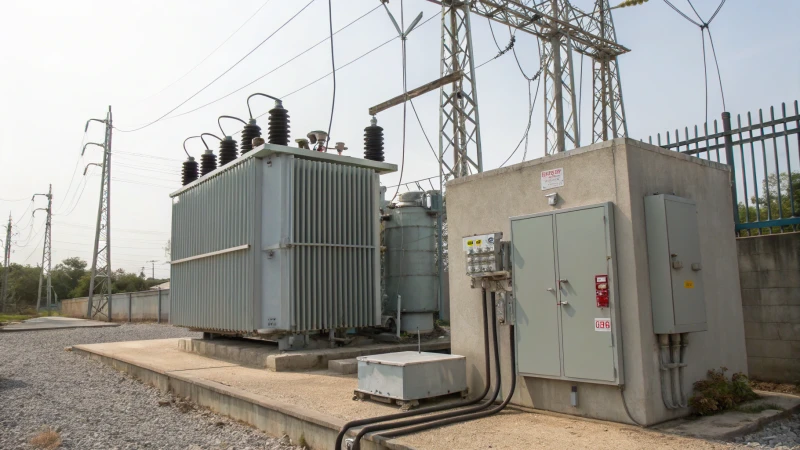Short-circuit impedance is a critical parameter in the operation of power transformers, representing the resistance and reactance that a transformer presents when subjected to a short circuit. Understanding short-circuit impedance is essential for evaluating the performance, efficiency, and fault tolerance of transformers in power systems. It plays a key role in determining the fault current levels, voltage regulation, and overall safety during short-circuit conditions.
In this article, we will explore what short-circuit impedance is, how it affects transformer performance, and how it is calculated. We'll also discuss its importance in the design and operation of power transformers.
What is Short-Circuit Impedance in Power Transformers?

Short-circuit impedance is a critical parameter in the design, operation, and protection of power transformers. It refers to the impedance (resistance and reactance) of a transformer when a short-circuit condition occurs at its secondary terminals. Understanding short-circuit impedance is essential for transformer performance, safety, and for the correct sizing of protection devices. In this article, we will explore the concept of short-circuit impedance, how it affects transformer performance, and its role in the protection of power systems.
What is Short-Circuit Impedance?
Short-circuit impedance is defined as the total impedance (both resistive and reactive) that a transformer presents when subjected to a short-circuit on its output or secondary side. It is a crucial factor in calculating the fault current that can occur during a short-circuit event, which influences the design of protection systems.
When a short-circuit occurs, a transformer’s impedance limits the amount of fault current that flows through the system. This impedance is typically expressed as a percentage of the transformer’s rated voltage, and it plays a significant role in determining how much the transformer will limit or reduce the fault current.
Short-circuit impedance can be broken down into two components:
- Resistive Impedance (R): This is the portion of the impedance that is caused by the resistance of the transformer windings. It converts electrical energy into heat.
- Reactive Impedance (X): This is the portion of the impedance caused by the transformer’s inductive reactance, which resists changes in current and is a result of the magnetic fields generated by the transformer’s windings.
Why is Short-Circuit Impedance Important in Power Transformers?
Short-circuit impedance plays a vital role in ensuring the safe and stable operation of transformers and the entire power system. Below are some of the key reasons why short-circuit impedance is important:
1. Limiting Fault Current
In the event of a short-circuit, the fault current could potentially be very large, which would place the transformer and other electrical equipment at risk of severe damage. Short-circuit impedance limits the amount of current that can flow during such an event, thereby preventing equipment damage and reducing the risk of fire or explosions.
The short-circuit impedance is responsible for controlling the fault current magnitude. Higher impedance results in lower fault current, while lower impedance leads to higher fault current.
2. Protection Coordination
Transformer protection schemes (such as overcurrent relays and fuse protection) rely heavily on short-circuit impedance to determine the correct protection settings. By knowing the short-circuit impedance, engineers can correctly set the pickup values for the relays and time-delay settings to ensure that the protection devices respond appropriately to different types of faults, avoiding unnecessary trips and minimizing downtime.
3. Voltage Regulation and Load Sharing
The voltage drop across the short-circuit impedance affects how the transformer performs under different load conditions. When a transformer is supplying a load, the voltage at the secondary terminals can drop due to the impedance, which impacts voltage regulation. The short-circuit impedance must be carefully considered to ensure that the voltage drop is within acceptable limits for the safe operation of downstream equipment.
Additionally, when multiple transformers are connected in parallel, load-sharing between the transformers is influenced by their short-circuit impedances. Transformers with lower short-circuit impedances will carry more load compared to those with higher impedance.
4. Thermal Stress and Overheating Risks
If a short-circuit occurs, the fault current can cause excessive thermal stress in the transformer windings. The resistive component of the short-circuit impedance contributes to heating. Transformers with lower short-circuit impedance will have higher fault currents and therefore experience more heat generation, which could result in insulation damage and reduced transformer lifespan. Managing short-circuit impedance ensures that the transformer does not experience excessive heating during fault conditions.
Short-Circuit Impedance Calculation
Short-circuit impedance is usually determined during the transformer testing phase and is given as a percentage of the rated voltage. It is calculated by applying a known voltage to the transformer primary side, while the secondary side is shorted. The resulting current is measured, and the impedance is calculated using Ohm’s law.
The formula for calculating short-circuit impedance is:
[Z{sc} = \frac{V{sc}}{I{sc}} = \frac{V{\text{rated}} \times \text{percentage impedance}}{100}]
Where:
- (Z_{sc}) = Short-circuit impedance
- (V_{sc}) = Voltage applied during short-circuit test
- (I_{sc}) = Current during short-circuit test
- (V_{\text{rated}}) = Rated voltage of the transformer
- Percentage Impedance = Value expressed as a percentage of the rated voltage
Factors Affecting Short-Circuit Impedance
Several factors affect the short-circuit impedance of a transformer, including the design of the transformer, winding configuration, and core material. The primary factors influencing short-circuit impedance are:
1. Transformer Winding Configuration
The winding configuration plays a significant role in determining the reactance component of the short-circuit impedance. A transformer with more turns in the winding will typically have a higher inductive reactance, increasing the overall impedance. On the other hand, a transformer with less winding resistance will have a lower resistive component.
2. Transformer Rating
The rating of the transformer (i.e., its power capacity) also affects the short-circuit impedance. Larger transformers typically have lower short-circuit impedances compared to smaller ones. This is because larger transformers can withstand higher fault currents without significant damage.
3. Core Material and Design
The type of core material used in a transformer (such as silicon steel or amorphous steel) can influence the magnetic flux and the transformer’s reactive impedance. Higher-quality core materials reduce core losses and lower the reactive component of the impedance, improving efficiency and reducing fault currents.
4. Fault Location and Impedance Path
The location of the fault (whether at the primary or secondary side) and the impedance path through the transformer’s windings can also affect the short-circuit impedance. A fault closer to the transformer’s primary side will experience a different impedance compared to a fault occurring on the secondary side.
Impact of Short-Circuit Impedance on Transformer Protection
The protection systems in place for transformers, such as relays and circuit breakers, rely on the short-circuit impedance to make informed decisions about when to disconnect the transformer from the electrical system during a fault.
If the short-circuit impedance is low, the fault current will be higher, and protection devices must be calibrated to detect the overcurrent quickly to prevent transformer damage. Conversely, high short-circuit impedance means lower fault currents, and the protection system needs to account for this lower current level to avoid unnecessary tripping of the system.
What Are the Components of Short-Circuit Impedance in Transformers?
Short-circuit impedance is an essential characteristic of power transformers that dictates the behavior of the transformer during a fault, particularly during a short-circuit event. Understanding the components of short-circuit impedance is crucial for designing protection systems, ensuring safe operation, and managing transformer performance under fault conditions. Short-circuit impedance is made up of two primary components: resistive impedance and reactive impedance. These two components together determine how much fault current will flow through the transformer during a short-circuit, and they impact the efficiency, stability, and protection of the power system.
In this article, we will break down the key components of short-circuit impedance, their functions, and how they impact transformer design and protection.
What are the Components of Short-Circuit Impedance?
Short-circuit impedance is composed of the following key components:
- Resistive Impedance (R)
- Reactive Impedance (X)
Together, these two components define how much resistance and reactance the transformer presents under fault conditions. Let’s take a closer look at each of these components.
1. Resistive Impedance (R)
Resistive impedance is the real component of the short-circuit impedance and is caused by the resistance of the transformer’s windings. The primary function of resistive impedance is to limit the amount of current flowing through the transformer during a fault. When current flows through a resistive material, it generates heat due to the Joule heating effect, which can be a concern if the current is too high. In transformers, this heat is absorbed by the windings and the insulation, potentially leading to overheating and damage if not managed properly.
The resistive component of short-circuit impedance can be calculated using the formula:
[R = \frac{V}{I}]
Where:
- (R) = Resistive impedance
- (V) = Voltage across the transformer windings
- (I) = Current through the transformer windings
Role of Resistive Impedance:
- Heat Generation: The resistance causes heat generation, which needs to be managed to prevent overheating and insulation degradation.
- Losses: Resistive losses reduce the overall efficiency of the transformer during fault conditions.
- Current Limiting: The higher the resistive impedance, the lower the fault current that will flow through the system.
Impact of Resistive Impedance on Fault Conditions:
- High resistive impedance reduces the fault current but generates more heat in the transformer windings.
- Excessive resistive impedance can lead to inefficient fault response and excessive heating, potentially damaging the transformer.
2. Reactive Impedance (X)
Reactive impedance is the imaginary component of the short-circuit impedance and arises due to the inductive reactance of the transformer. This component is influenced by the magnetic field generated by the current flowing through the windings. Reactive impedance opposes changes in current and is primarily responsible for the transformer’s inductive behavior during normal operation as well as during faults.
In simpler terms, reactive impedance is caused by the transformer's core and winding inductance. The magnetic field created by the current induces a voltage that opposes the change in current, slowing down the response of the transformer during fault conditions.
The reactive impedance is typically calculated using the formula:
[X = 2\pi f L]
Where:
- (X) = Reactive impedance
- (f) = Frequency of the electrical system
- (L) = Inductance of the transformer windings
Role of Reactive Impedance:
- Inductive Behavior: It causes the transformer to resist sudden changes in current, which can affect the transformer’s response during a fault.
- Voltage Regulation: The reactive component is responsible for voltage drop across the transformer during fault conditions. Transformers with higher reactive impedance can experience significant voltage sag during faults.
- Fault Current Limiting: Similar to resistive impedance, the reactive impedance helps in limiting the fault current during a short-circuit event, but its impact is more pronounced in the reactive power aspect of the fault.
Impact of Reactive Impedance on Fault Conditions:
- High reactive impedance means that the transformer will resist the change in current more effectively, leading to a lower fault current.
- Reactive impedance can affect the voltage drop during a fault, which needs to be considered in the design of the transformer’s protection scheme.
Total Short-Circuit Impedance:
The total short-circuit impedance (Z_{sc}) is a combination of both resistive and reactive components. It can be expressed as:
[Z_{sc} = R + jX]
Where:
- (Z_{sc}) = Total short-circuit impedance
- (R) = Resistive impedance
- (X) = Reactive impedance
- (j) = Imaginary unit, representing the inductive nature of the reactance
This impedance determines how much current will flow when a fault occurs at the transformer’s secondary terminals. It is typically expressed as a percentage of the transformer’s rated voltage, and it is a key factor in calculating fault current, as well as in the design of protection systems.
What Factors Influence the Components of Short-Circuit Impedance?
Several factors influence the resistive and reactive components of short-circuit impedance, including:
1. Transformer Design:
The design of the transformer windings, core, and insulation can impact both the resistive and reactive impedance. For instance, the winding material (such as copper or aluminum) and the number of turns in the winding influence both resistance and reactance.
2. Voltage Rating:
The voltage rating of the transformer impacts the overall impedance. Transformers with higher voltage ratings generally have lower short-circuit impedances in comparison to those with lower voltage ratings.
3. Transformer Size and Capacity:
Larger transformers typically have lower short-circuit impedances compared to smaller transformers. This is due to the larger cross-sectional area of the windings and the larger core, which reduce the overall impedance.
4. Core Material:
The material used in the transformer’s core, such as silicon steel or amorphous steel, affects the reactive impedance. High-quality core materials result in reduced core losses and lower reactance.
5. Load Conditions:
The load connected to the transformer affects the overall impedance. Under light load conditions, the transformer’s impedance may behave differently than under full load, impacting the fault current.
Why is Short-Circuit Impedance Important for Power Transformers?

Short-circuit impedance is a critical parameter in power transformer design and operation, playing a central role in transformer protection, fault management, and overall system reliability. During short-circuit conditions, when an abnormal low-resistance path is created in the electrical network, the flow of fault current increases rapidly, potentially leading to transformer damage or system failure. The short-circuit impedance directly affects the magnitude of this fault current, influencing how effectively the transformer can handle such conditions.
Understanding why short-circuit impedance is important is essential for both transformer design engineers and operators aiming to ensure the transformer operates safely and efficiently in a power system. Below, we will discuss the fundamental reasons short-circuit impedance is so crucial for power transformers and how it affects their performance and safety.
1. Limiting Fault Current
One of the most important roles of short-circuit impedance is to limit the fault current that flows through the transformer during abnormal conditions. Short-circuit conditions can occur for various reasons, such as insulation failure, equipment malfunction, or external damage. If fault currents are not limited, they can cause severe damage to the transformer’s internal components, such as windings, core, and insulation.
Short-circuit impedance essentially acts as a current-limiting mechanism that prevents excessive current from flowing through the transformer. By controlling the fault current, short-circuit impedance helps prevent damage to the transformer, minimizes fire hazards, and reduces the likelihood of cascading failures across the electrical network.
2. Transformer Protection and Safety
Short-circuit impedance is critical in designing a transformer's protection system. The higher the impedance, the lower the fault current that will flow when a short-circuit occurs. This lower fault current reduces the likelihood of overcurrent damage and ensures that the protective relay systems can effectively detect and isolate faults without causing excessive stress on the transformer.
- Overcurrent Protection: Transformers with appropriate short-circuit impedance help in the accurate sizing and setting of overcurrent protection relays. By controlling the amount of fault current, the relays can activate more efficiently and prevent damage to the transformer windings.
- Thermal Protection: High fault currents generate excessive heat, which can damage insulation and other transformer components. Short-circuit impedance limits this current, reducing the heat generated during fault conditions and preventing thermal runaway.
3. Voltage Regulation During Faults
Short-circuit impedance also affects the voltage regulation of the transformer during fault conditions. When a short-circuit occurs, the impedance will cause a voltage drop across the transformer windings. This drop in voltage can result in voltage instability, which may impact sensitive loads connected to the transformer, such as industrial equipment, computers, and other critical systems.
Having the right level of short-circuit impedance ensures that the transformer can maintain an appropriate voltage level during fault conditions, minimizing the voltage sag and oscillations that may otherwise disrupt operations in downstream systems.
4. Impedance and Fault Current Calculation
Short-circuit impedance plays a vital role in calculating the fault current that flows through the transformer during short-circuit conditions. The fault current is a critical factor in both transformer design and protection system configuration. Accurate fault current calculations help engineers select appropriate protective devices, such as circuit breakers, fuses, and relays, that will respond quickly enough to isolate the fault without causing damage to the transformer.
The total short-circuit impedance is a combination of both resistive and reactive impedance (resistance and inductance). A lower impedance results in a higher fault current, which could overwhelm the transformer’s internal components and the electrical system’s protection mechanisms. On the other hand, a higher impedance results in a lower fault current, which helps maintain transformer and system integrity during faults.
5. Impact on Transformer Sizing
The magnitude of short-circuit impedance influences how much physical space the transformer requires for its design. Transformers with lower impedance generally need larger core and winding dimensions to handle higher fault currents. On the other hand, transformers with higher impedance may have more compact designs but may experience higher losses due to their inherent resistance.
By considering short-circuit impedance when selecting transformer ratings and specifications, engineers can ensure that the transformer is appropriately sized to manage fault conditions and provide reliable service over its operational life.
6. Short-Circuit Impedance and System Coordination
Short-circuit impedance also has implications for system coordination in the overall electrical network. A power system involves various interconnected transformers, circuit breakers, and protective relays. The short-circuit impedance of each transformer plays a role in determining how fault currents propagate throughout the system. Transformers with higher impedance help limit the impact of short-circuit conditions on adjacent equipment, preventing a cascade of failures in the grid.
7. Influence on System Stability and Reliability
The ability of a transformer to withstand short-circuit conditions without causing damage is directly related to its impedance. Short-circuit impedance impacts the stability of the transformer under fault conditions and ensures that it can handle short-circuit events without destabilizing the entire electrical system. The system’s reliability depends on the transformer’s ability to recover quickly after a fault, and the right level of short-circuit impedance helps maintain this stability.
A transformer with proper short-circuit impedance ensures that it can endure fault currents, recover efficiently, and continue functioning safely, helping to protect downstream consumers and ensure the long-term operation of the power system.
How is Short-Circuit Impedance Measured and Calculated?
Short-circuit impedance is a key parameter in the design and operation of power transformers, as it directly influences how a transformer reacts during fault conditions. Understanding how to measure and calculate short-circuit impedance is essential for ensuring the safety, reliability, and efficiency of a transformer. The impedance essentially dictates the magnitude of the fault current, playing a critical role in fault protection, system stability, and transformer longevity.
This article will walk you through the methods and steps involved in measuring and calculating short-circuit impedance, helping both engineers and operators understand how to assess transformer performance during abnormal conditions.
1. Understanding Short-Circuit Impedance
Before delving into measurement and calculation techniques, it's essential to define what short-circuit impedance actually is. Short-circuit impedance in a transformer refers to the opposition to the flow of current when a short-circuit fault occurs in the system. This impedance is a combination of:
- Resistive impedance (R): This is the real part of the impedance, primarily due to the winding resistance. It limits the flow of current during fault conditions and contributes to heat generation in the transformer.
- Reactive impedance (X): This is the imaginary part of the impedance, largely due to the transformer’s inductance. It impacts how the transformer responds to alternating currents and affects the fault current flow.
Together, these two components determine how much fault current will flow through the transformer and its windings during a short-circuit event.
2. Methods to Measure Short-Circuit Impedance
The most common method to measure short-circuit impedance in transformers is through direct testing using specialized equipment. The standard procedure is called the short-circuit test. During this test, one side of the transformer is shorted, and the other side is subjected to a controlled voltage.
Short-Circuit Test Procedure:
-
Preparation of the Transformer:
- Disconnect the transformer from any live power system.
- Ensure that the transformer is properly grounded and isolated for safety.
- Make sure all the measuring equipment (voltage, current, and impedance meters) is set up correctly.
-
Performing the Short-Circuit Test:
- Short-circuit one of the transformer windings (usually the low-voltage side) using a shorting wire or test bus.
- Apply a low-voltage supply to the primary (high-voltage) side of the transformer.
- Gradually increase the voltage and monitor the current until the rated short-circuit current is reached.
- Record the voltage (V) applied and the current (I) flowing through the transformer under short-circuit conditions.
-
Calculating the Impedance:
- Once the voltage and current are recorded, the short-circuit impedance (Z) can be calculated using Ohm’s Law:
[Z = \frac{V}{I}] - Where:
- (Z) is the short-circuit impedance in ohms (Ω).
- (V) is the voltage applied across the winding.
- (I) is the current measured during the short-circuit test.
- Once the voltage and current are recorded, the short-circuit impedance (Z) can be calculated using Ohm’s Law:
-
Impedance at Rated Current:
- To ensure accuracy, the short-circuit impedance is usually expressed as a percentage of the transformer’s rated impedance. This value is often recorded as a percentage based on the rated current or the rated voltage of the transformer. This helps standardize measurements across different transformers and systems.
Example Calculation:
Let’s assume that during a short-circuit test, the following values are measured:
- Voltage (V = 100 \, \text{V})
- Current (I = 10 \, \text{A})
Using Ohm’s law:
[Z = \frac{100 \, \text{V}}{10 \, \text{A}} = 10 \, \Omega]
The impedance under these conditions is 10 ohms.
3. Short-Circuit Impedance and Transformer Ratings
In addition to direct measurement, transformer manufacturers typically provide short-circuit impedance values in the transformer’s technical specifications. These values are calculated based on standard industry methods and are used to design protection systems and ensure compatibility with the power grid.
The short-circuit impedance value is often given as a percentage of the transformer’s rated impedance. This percentage tells you how much the impedance varies from the nominal operating conditions when a fault occurs.
For example, a transformer might have a short-circuit impedance of 5%, meaning the impedance during a short-circuit test is 5% of the rated value of the transformer.
4. Importance of Short-Circuit Impedance in Power Systems
- Fault Current Limitation: Short-circuit impedance directly limits the magnitude of fault currents, preventing damage to the transformer and other components in the system.
- Protection Coordination: Accurate short-circuit impedance values help in the proper coordination of protection devices like circuit breakers and fuses, ensuring that they respond effectively during fault conditions without unnecessarily disconnecting the transformer from the grid.
- Thermal and Mechanical Stress: By limiting fault current, short-circuit impedance also minimizes the thermal and mechanical stresses experienced by transformer windings and other internal components, thereby prolonging the transformer’s lifespan.
5. Calculating Impedance for Multiple Windings
For transformers with multiple windings (e.g., step-up or step-down transformers), short-circuit impedance is typically measured between pairs of windings (primary to secondary, and vice versa). In this case, the impedance calculations may involve complex transformations and phase shifts due to the differing voltage levels between the windings.
Formula for Impedance with Multiple Windings:
For a transformer with two windings, the impedance (Z_{total}) is calculated considering both the primary and secondary windings and their respective voltage ratios. The calculation involves adjusting the measured short-circuit impedance for the voltage ratio between the windings:
[Z{total} = \frac{Z{measured}}{(V{primary}/V{secondary})^2}]
Where:
- (Z_{measured}) is the short-circuit impedance measured in one winding.
- (V{primary}) and (V{secondary}) are the voltage ratings of the primary and secondary windings, respectively.
This formula helps to account for the transformer’s turns ratio and ensures that impedance is accurately reflected for the entire transformer configuration.
How Does Short-Circuit Impedance Affect Transformer Protection and Safety?

Short-circuit impedance is a critical factor in determining how a transformer behaves during fault conditions, directly affecting the transformer’s protection mechanisms and safety protocols. When a short-circuit fault occurs in a power system, the fault current can potentially damage transformers, disrupt the entire power distribution network, and cause significant safety hazards. This is where short-circuit impedance plays an essential role in mitigating these risks.
Understanding how short-circuit impedance impacts transformer protection is vital for ensuring the reliability, longevity, and safety of transformers, especially in high-voltage environments.
1. The Role of Short-Circuit Impedance in Limiting Fault Current
When a short-circuit fault occurs in an electrical system, the fault current can be hundreds or even thousands of times higher than the normal operating current. This surge in current, if left unchecked, can cause significant damage to transformer windings, insulation, and other components, as well as pose a serious fire and electrical hazard.
Short-circuit impedance (Z) helps limit the flow of fault current by providing a resistance to the current flow. The higher the impedance, the lower the fault current that will flow through the transformer when a short-circuit occurs. This reduces the stress on transformer components and prevents excessive heat generation, which could otherwise lead to damage or failure of the transformer.
The impedance is made up of two components:
- Resistive impedance (R): Limits current flow and converts electrical energy into heat.
- Reactive impedance (X): Opposes changes in current flow and influences the phase difference between voltage and current.
By carefully managing short-circuit impedance, engineers can control fault current levels and, in turn, design protection systems that can prevent severe damage to transformers during fault conditions.
2. How Short-Circuit Impedance Affects Protection Coordination
The primary purpose of transformer protection is to disconnect the transformer from the grid during fault conditions to prevent irreversible damage. To achieve this, protection systems rely on precise measurements of fault current, which is influenced by the transformer’s short-circuit impedance.
Effective protection coordination ensures that the transformer disconnects promptly when a fault occurs without unnecessarily triggering circuit breakers or fuses in other parts of the power system. If short-circuit impedance is too low, the fault current will be too high, which might not allow protection devices (such as circuit breakers, fuses, or relays) to react fast enough to protect the transformer. On the other hand, if impedance is too high, it could delay fault detection and response times, potentially allowing the fault to persist and cause further damage.
To achieve optimal protection, short-circuit impedance must be aligned with the settings of the protection devices. This ensures that the protection system will react appropriately based on the fault current levels, thereby preventing both overcurrent and underreaction during faults.
3. Influence on Thermal Stress and Mechanical Stability
During a short-circuit, the sudden surge of electrical current generates intense thermal and mechanical stresses on the transformer. These stresses can cause:
- Overheating of transformer windings, insulation, and other internal components.
- Mechanical vibrations and shocks that can cause damage to the core and windings.
The short-circuit impedance limits the fault current, thus reducing these stress levels. A high short-circuit impedance results in a lower fault current, which, in turn, minimizes the thermal stress on the transformer and reduces the mechanical forces that could potentially damage the internal components.
For example, transformers with a higher short-circuit impedance are generally more resilient to thermal runaway or mechanical deformation under fault conditions, improving their overall safety during transient faults. In contrast, transformers with lower impedance are more vulnerable to rapid temperature rises and physical damage during short-circuit events.
4. Short-Circuit Impedance and Fault Detection Accuracy
Fault detection relies heavily on the ability of protection devices (such as overcurrent relays and distance relays) to sense abnormal fault currents and disconnect the transformer. The fault current is directly impacted by the short-circuit impedance, meaning that incorrect impedance values can lead to false trips or failure to trip during faults.
- False tripping: If the short-circuit impedance is too low, the protection device might trip the transformer unnecessarily, leading to disruptions in service.
- Failure to trip: If the short-circuit impedance is too high, the fault current may remain below the threshold of the protection device, causing the transformer to remain connected to the faulted system, which can lead to severe damage.
5. Short-Circuit Impedance and Protection Devices
The type of protection devices used in a power system is closely related to the transformer's short-circuit impedance. Common protection mechanisms include:
- Fuses: These are designed to blow when the fault current exceeds a certain threshold. The higher the short-circuit impedance, the lower the fault current, which can influence whether or not the fuse blows quickly enough.
- Circuit Breakers: These can interrupt the flow of current during fault conditions. Short-circuit impedance affects the current that the circuit breaker needs to interrupt, and the breaker’s tripping characteristics must be properly coordinated with the transformer's impedance.
- Relays: Protection relays detect the level of current and trip circuit breakers accordingly. A relay must be calibrated to the expected fault current, which is determined by the transformer’s impedance.
Protection Device Coordination:
To ensure transformer safety, short-circuit impedance values must be used in conjunction with the time-current characteristics of the protection devices. For example:
- A transformer with a low short-circuit impedance might require fast-acting protection, as the fault current will rise quickly and reach dangerous levels.
- A transformer with a higher short-circuit impedance may need slower protection response times to avoid unnecessary tripping and system disruption.
6. Long-Term Impact on Transformer Lifespan
The ability of short-circuit impedance to limit fault current and reduce thermal and mechanical stress has a direct impact on the transformer’s lifespan. Transformers exposed to high fault currents due to low impedance may experience accelerated insulation breakdown, core damage, and thermal aging, all of which contribute to a shorter operational life.
By ensuring that short-circuit impedance is set to appropriate levels, a transformer is better protected against these risks, leading to longer lifespan, reduced downtime, and fewer repairs, thus improving the cost-effectiveness and reliability of the system.
What Are the Typical Values of Short-Circuit Impedance for Power Transformers?

Short-circuit impedance is a critical parameter when designing and operating power transformers. It affects not only the fault current levels but also the protection settings and overall transformer performance during fault conditions. Understanding the typical values of short-circuit impedance can help ensure that transformers are correctly sized and adequately protected for their applications.
What is Short-Circuit Impedance?
Before diving into the typical values, it's essential to understand what short-circuit impedance is. Short-circuit impedance, typically represented by the symbol (Z_{sc}), is the opposition that a transformer presents to the flow of current during a short-circuit condition. It is made up of two components:
- Resistive Impedance (R): This limits the flow of current by converting electrical energy into heat.
- Reactive Impedance (X): This resists changes in current and impacts the phase relationship between voltage and current.
The short-circuit impedance is usually expressed as a percentage (%), which indicates the fraction of the rated voltage required to produce full-load current under short-circuit conditions.
Typical Values of Short-Circuit Impedance
The values of short-circuit impedance vary depending on several factors, including transformer size, application, voltage level, and design type. Below are typical values for short-circuit impedance in different categories of power transformers:
1. Low-Voltage Distribution Transformers
- Typical Impedance Values: 2% to 6%
- Description: Low-voltage distribution transformers, often used for residential or light industrial applications, typically have short-circuit impedance values in this range. These transformers are designed to handle lower power levels and have relatively low fault current levels, making their impedance higher compared to larger transformers.
2. Medium-Voltage Power Transformers
- Typical Impedance Values: 5% to 10%
- Description: Medium-voltage transformers, which are commonly used for industrial, commercial, and distribution substation applications, usually have a short-circuit impedance between 5% and 10%. These transformers are designed to handle higher power loads and therefore have higher short-circuit impedance than low-voltage transformers to limit fault current.
3. High-Voltage Power Transformers
- Typical Impedance Values: 8% to 15%
- Description: High-voltage transformers, which are used in transmission systems to step down from ultra-high voltages (e.g., 110kV and above) to more manageable voltages for distribution, often exhibit higher short-circuit impedance. This is because high-voltage transformers are designed to handle very large amounts of power and need to withstand high fault currents. Their short-circuit impedance is set to limit the fault currents and avoid excessive damage.
4. Large Power Transformers for Industrial Use
- Typical Impedance Values: 6% to 12%
- Description: Transformers used in large industrial applications, such as steel mills, chemical plants, and large manufacturing facilities, typically have short-circuit impedance values between 6% and 12%. These transformers are designed to handle substantial power loads, and the impedance is carefully calculated to balance the need for limiting fault currents and providing stable operation under load.
5. Substation Transformers
- Typical Impedance Values: 6% to 10%
- Description: Transformers installed at substations to step down the transmission voltage to distribution voltage generally have short-circuit impedance values in this range. The impedance is chosen to ensure that fault currents remain within manageable levels while maintaining system stability and reliability.
6. Traction Transformers
- Typical Impedance Values: 6% to 9%
- Description: Transformers used for railway electrification or other transportation applications usually fall within this range. These transformers must be robust enough to withstand frequent load variations and short-circuit conditions, and their impedance is set to limit fault current while ensuring a reliable power supply for transportation systems.
Factors Influencing Short-Circuit Impedance Values
Several factors influence the selection and variation of short-circuit impedance in transformers:
- Transformer Size and Power Rating: Larger transformers (in terms of power handling) tend to have lower impedance values since they are designed to handle greater fault currents.
- Voltage Level: Higher-voltage transformers typically have higher short-circuit impedance to protect against larger fault currents that can arise from high-voltage systems.
- Type of Load: The type of load connected to the transformer affects the impedance selection. Industrial loads typically require transformers with lower short-circuit impedance to ensure higher reliability and better fault tolerance.
- Cooling Mechanism: Transformers with more efficient cooling systems may allow for higher current flows during fault conditions, which can influence their impedance.
- Design Standards: Different industries and regions may follow varying standards for impedance. For instance, utility companies may use different standards compared to industrial plants, influencing the design of short-circuit impedance.
Importance of Short-Circuit Impedance in Transformer Protection
Short-circuit impedance plays an essential role in the protection coordination of power transformers. The impedance helps in setting the fault current limits, which in turn influences the response time of protection devices such as circuit breakers, fuses, and relays. Proper coordination ensures:
- Quick isolation of faulted sections to minimize damage.
- Prevention of excessive current from causing transformer damage or system failure.
- Avoidance of unnecessary shutdowns in other parts of the grid or system.
By understanding the short-circuit impedance and selecting the appropriate values, engineers can design protection systems that keep transformers safe while maintaining system stability.
How to Calculate Short-Circuit Impedance
Short-circuit impedance can be calculated using the following formula:
[Z{sc} = \frac{V{sc}}{I_{sc}} \times 100]
Where:
- (V_{sc}) is the voltage applied during the short-circuit test.
- (I_{sc}) is the current that flows during the short-circuit test.
The impedance value is expressed as a percentage of the rated voltage. Lower impedance values result in higher fault currents, while higher impedance values reduce the fault current magnitude.
Conclusion
Short-circuit impedance in power transformers is a crucial factor for determining the fault tolerance and voltage stability of electrical systems. It is made up of two components: resistive (R) and reactive (X) impedance, which together determine how the transformer will respond to a short circuit.
The impedance affects key operational aspects such as fault current levels and voltage regulation. A transformer with higher short-circuit impedance will limit the fault current but may have more significant voltage drops under load. On the other hand, a transformer with lower short-circuit impedance will allow higher fault currents, which can lead to more rapid protection responses but may result in higher voltage drops during normal operation.
Measuring short-circuit impedance typically involves conducting specific tests under controlled conditions, often using a test power source to simulate a short circuit at the transformer's secondary side while measuring the current and voltage.
Understanding and correctly calculating short-circuit impedance is crucial for designing appropriate protection systems (e.g., overcurrent protection, circuit breakers) to ensure the safety and reliability of power transformers and the larger power system. Short-circuit impedance is an integral part of the overall transformer design and must be carefully considered when selecting transformers for particular applications, ensuring that the transformer can handle fault conditions without failure.
In summary, short-circuit impedance is a key performance indicator for power transformers that influences both their operational efficiency and their ability to withstand fault conditions. Properly understanding and managing it is essential for ensuring safe, reliable, and efficient power distribution.
FAQ
Q1: What is short-circuit impedance in power transformers?
A1: Short-circuit impedance in power transformers refers to the impedance (resistance and reactance) that the transformer presents to the flow of current during a short circuit. It limits the current during fault conditions, protecting the transformer and connected equipment from damage. Short-circuit impedance is a key factor in the design of transformers and plays a crucial role in fault protection and voltage regulation.
Q2: How does short-circuit impedance affect transformer performance?
A2: Short-circuit impedance limits the magnitude of the fault current during a short circuit, thus preventing excessive heating and mechanical stress on transformer windings. It also affects the voltage drop across the transformer under load conditions. Higher impedance values lead to a greater voltage drop and may reduce the transformer’s efficiency, while lower impedance allows for more efficient current flow during normal operation.
Q3: How is short-circuit impedance calculated in power transformers?
A3: Short-circuit impedance is calculated using the formula:
Z = V / I,
where:
V is the voltage at the transformer's primary or secondary terminals,
I is the short-circuit current measured under fault conditions.
Alternatively, it can be calculated from the transformer’s nameplate ratings and its equivalent circuit parameters, considering factors like reactance and resistance.
Q4: Why is short-circuit impedance important for fault protection?
A4: Short-circuit impedance is critical for fault protection because it limits the short-circuit current, preventing it from reaching dangerous levels. By controlling the fault current, it ensures that protective devices like circuit breakers or fuses can operate effectively, disconnecting the transformer from the circuit before damage occurs. It also ensures that the transformer operates safely under fault conditions, reducing the risk of catastrophic failures.
Q5: Can short-circuit impedance be adjusted in a transformer?
A5: While the short-circuit impedance is typically determined during the manufacturing process and is based on the transformer's design, some factors like the choice of winding configuration, core material, and cooling methods can influence it. However, it is not usually adjustable once the transformer is in operation. In some cases, external equipment such as impedance matching devices can be used to mitigate the effects of high impedance.
References
"Understanding Short-Circuit Impedance in Power Transformers" - https://www.transformertech.com/short-circuit-impedance - Transformer Tech
"The Role of Short-Circuit Impedance in Transformer Design" - https://www.powermag.com/short-circuit-impedance - Power Magazine
"How Short-Circuit Impedance Affects Transformer Performance" - https://www.electrical4u.com/short-circuit-impedance - Electrical4U
"Calculation of Short-Circuit Impedance in Transformers" - https://www.sciencedirect.com/topics/engineering/short-circuit-impedance - ScienceDirect
"Transformer Short-Circuit Protection and Impedance" - https://www.researchgate.net/short-circuit-impedance-transformers - ResearchGate
"The Importance of Short-Circuit Impedance in Electrical Systems" - https://www.smartgridnews.com/short-circuit-impedance - Smart Grid News
"Short-Circuit Impedance and Its Impact on Transformer Efficiency" - https://www.energycentral.com/c/ee/short-circuit-impedance-impact - Energy Central
"Transformer Short-Circuit Impedance and Current Limiting" - https://www.powergrid.com/short-circuit-impedance - PowerGrid



